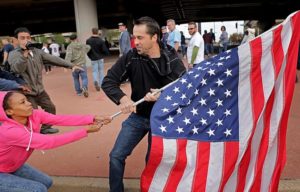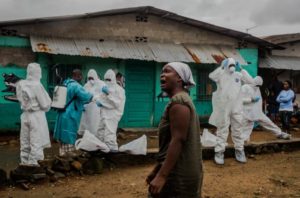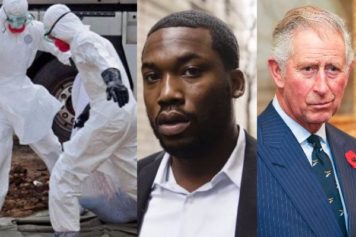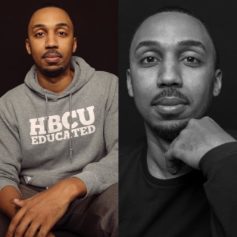When I gaze at the arresting images from Ferguson and from the Ebola crisis in Liberia that were awarded Pulitzer Prizes for photography this year, I can’t help but think about the words of Mark Sealy, the curator of a fascinating exhibit called “Human Rights Human Wrongs” that ran earlier this year at The Photographers Gallery in London.
A major part of Sealy’s interest is in the depiction of Black bodies when they are presented to the world through the lenses of Western photographers, published for Western eyes in Western publications. That orientation has created in the Western (read: white) mind a conditioning to view Black people a certain way.
“The way photojournalism deals with the racialised subject is an important inquiry and one I wanted to draw attention to because it seems to me that the black figure, the non-European subject, is often photographed in the most broken of conditions,” Sealy writes in an essay accompanying his exhibit. “It is almost as if it is visually acceptable to look at these people in the most debased of scenarios; whereas there is an absence of images that show us the European subject on the edge of life in the same way.”
Black people “in the most broken of conditions” is definitely the subtext of this year’s Prize winners.
New York Times photographer Daniel Berehulak’s pictures from Liberia of the excruciating pain delivered to families in the form of the Ebola epidemic are heartwrenching, evocative images. You can almost hear the loud, moaning cries rising up off the screen when you view them.
But they are at once consistent with the way we always view Black bodies in Africa—”in the most debased of scenarios,” in Sealy’s words. Surely it is understandable that a photojournalist working in Liberia on the Ebola story is going to want to capture images of pain and suffering. That is the lens through which we in the West have grown accustomed to seeing and understanding this disease. But imagine how differently the images would look, what a different picture we would form, if Berehulak had decided to capture—and the Pulitzer Prize board had decided to award—a series of images intended to present to us the courage and heroism of the African doctors and healthcare workers who were without hesitation diving into the rescue of their countrymen and women. Think about the image of Africans that would form in our mind and how different it would be than the pain and suffering we have grown so accustomed to.
The award-winning images from Ferguson are far more problematic. The pictures were shot by David Carson and Robert Cohen of the St. Louis Post-Dispatch. The first image by Carson depicts a Black woman protester struggling to hold onto her American flag as a white football fan tries to take it away from her outside the Edward Jones Dome after a St. Louis Rams game. The message is obvious and powerful as these two Americans fight over the true meaning of the American flag—and whose flag (and country) it really is, with the white man clearly believing the Black woman has no rights to the flag.
The next Carson image shows a large Black man with a gun in his waistband and a black scarf covering his mouth looting from a QuikTrip store during the Ferguson protests after the death of Michael Brown. Other looters can be seen in the background.
The image by Cohen shows a young man who is named as Edward Crawford throwing back a teargas canister that was fired at Ferguson protesters by police.
With the hundreds of peaceful protests that flowed across the nation, from Ferguson to Oakland to New York, this is what the Pulitzer committee chose to honor and celebrate—African-American violence and lawlessness. In the eyes of the Pulitzer Prize committee, this should be the visual takeaway from this incredibly powerful and moving year of upheaval that questioned the very foundation of longstanding American institutions like law enforcement and the criminal justice system.
Sealy also addressed this traditional white bias in his essay.
“If you look at the images on view here, a very definite pattern starts to emerge,” he said of the pictures in his exhibit. “Typically, Western soldiers are photographed in Christian poses, framed like dying Christs on crosses; whilst the African soldier is presented as a savage who needs to be tamed; a renegade who fights his war outside of the rules of conflict, outside the Geneva Convention. These references create very specific meaning and values, yet conditioned as we are, we’re largely unconscious of their effect.”
No, those Black people in Ferguson weren’t heroic soldiers straining against a brutal and racist system of abuse and exploitation. Instead, they were savages who loot QuikTrips and steal chewing gum from some poor, unfortunate retailer—in this case the 27th largest private company in the nation, which had $11.45 billion in revenue last year. Or they throw a teargas canister at some poor line of police—who in this case were armed as heavily as the US Marines.
There wasn’t enough action or storytelling in the many incredible images I’ve seen of protesters standing proud and strong as they press their point directly in the face of law enforcement?
Guess not.
As the journalists on the Pulitzer Prize committee sat there poring over photos, it’s unlikely they had at the top of their minds the idea that they were intentionally going to pick images that make Black people look bad. Surely they thought they were just capturing the big stories of the year.
But that’s precisely the point—when their subconscious mind is at work, it is directing them to choose images that fit in with their perception of the world, with the way they believe their readers see Black and white.
So therefore it’s not a stretch for them to reach for broken Black bodies to evoke emotion and sentimentality in Africa.
Or to pick the Black savage when they want to show conflict in America.
Because that is what their mind’s eye has always seen.






